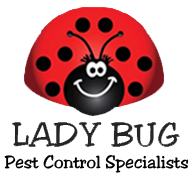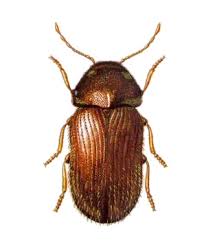|
If you examine either of these beetles from the side you notice their head tends to protrude downward, and is covered by the overhanging pronotum above it. The antenna is another important ID character, and you notice that the antenna of the Drugstore Beetle is composed of several very small segments followed by 3 much enlarged and much longer segments. These are all characters that you are unlikely to be able to see with the naked eye, and it is important that you have a small hand magnifier. Making the proper identification is the key to proper control. When you encounter a Drugstore Beetle infestation in the home it will be because the homeowner has observed the adult beetles wandering around in the cupboards, across the drain board, in the kitchen pantry, or even flying around, as they are good fliers. There are several larval sources to look for that seem to be the most common places of infestation. Dry kibbled dog food -- a major source of infestation and often stored in the cupboard under the kitchen sink next to the trash basket. In my own home we always kept a tub of large “doggie biscuits” in a cupboard in our laundry room, and these were subject to beetle infestations from time to time. Going right to this source sometimes can save a lot of time. Reach down to the bottom of the bag or carton and grab a handful of kibbles. Lay them out on the drain board and watch the adult Drugstore Beetles walk away from the pile. If adults are present break open some of the kibbled chunks and observe the larvae which can number as many as ten per kibble. Get this bagful of trouble off the property immediately by placing it in a plastic bag, sealing it closed, and disposing of it in the outdoor trash barrel. If your customer insists on salvaging the pet’s food it can be placed in a freezer until used again or placed in the oven at a low heat, perhaps only 120 degrees, for an hour. This should kill all the beetle eggs, larvae, pupae, and adults. Stored nuts are the next most important source. These are harder to find since homeowners tend to tuck bags of stored nuts in out-of-the-way places, intending to use them at a later date for "Christmas cookies" and then forgetting that they even have them. We occasionally are given bags of walnuts that are still in the shells, and I place the bag on a shelf in the garage with every intention of getting to them soon to crack the shells, pull out the meats, and store them in the freezer until needed. Those best-laid intentions sometimes are forgotten, and by the time I get to the nuts they are infested with Indian Meal Moth or beetles. Sometimes the homeowner can help the service technician find the bag while other times you are on your own. When you find the bag of nuts, pour the contents on the drain board and look for adult beetles walking away. Other pet food – this often may be fish food used to feed the pet fish in the family aquarium. The presence of an aquarium is a dead giveaway that this kind of material is stored somewhere, and you need to ask where it is stored. Examine it like you would examine the paprika. Don't overlook pet food for pet rats, birds, hamsters, etc. At Lady Bug use a variety of environmentally responsible products to control pest activity. The ECO line of products we use are all EPA approved and are made from clove oil, guava fruit, rosemary and other organic products and naturally occurring materials. They are very effective against pests when injected into the cracks and crevices at the source of where pests live and breed, yet it is inaccessible to people and pets. Drugstore Beetles Mesa, AZ Contact Lady Bug Pest Control Specialists for a Free Home Inspection for Termites, Eco-Friendly Pest Control, Home Seal Service, Bed Bug Eco-Heat, and Rodent Control. We perform Complete Home Inspections at no charge. Please feel free to contact Lady Bug Pest Control Specialists to answer any questions or for a FREE Inspection. 480-833-1111.
|
||
|
|




 The Drugstore Beetle is a small, brown, cylindrically-shaped beetle. If one looks at it closely through a hand magnifier it becomes apparent that the wing covers are indented with a series of closely spaced pits arranged in parallel lines. Compare this with the related Cigarette Beetle where the first wings that form the protective shell over the abdomen are very shiny, due to the presence of only very tiny pits in them.
The Drugstore Beetle is a small, brown, cylindrically-shaped beetle. If one looks at it closely through a hand magnifier it becomes apparent that the wing covers are indented with a series of closely spaced pits arranged in parallel lines. Compare this with the related Cigarette Beetle where the first wings that form the protective shell over the abdomen are very shiny, due to the presence of only very tiny pits in them.



